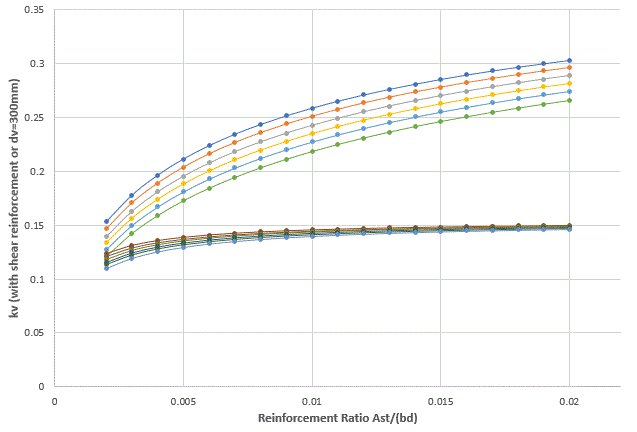I've done some algebraic manipulation of the General Method equations to get a feel for what they mean in practice. I've done two cases:
A) Minimum M* as given in 8.2.4.2.2(a)
B) M* = phi.Mu (approx.), called M*max below.
The assumptions include:
[ul]
[li]No prestressing or axial force[/li]
[li]phi(bending) = 0.85; phi(shear) = 0.70[/li]
[li]dv = 0.9*d[/li]
[li]Fy = 500 MPa; Es = 200 000 MPa[/li]
[li]M*max/dv = 0.85*Fy*Ast (ie lever arm of tension-compression couple = dv = 0.9*d; tension force = phi(bending)*Fy*Ast)[/li]
[/ul]
Setting V*=phi.Vuc then means that kv can be found by solving a quadratic equation:
0 = a*kv^2 + b*kv + c
For Case A (minimum bending moment): a = sqrt(f'c)/(84.6*p); b = 2.5; c = -1 (where >Asv,min provided) or -1*1300/(1000+kdg*dv) (<Asv,min; see equation 8.2.4.2(1)).
For case B (~maximum bending moment): a = sqrt(f'c)/(169.3*p); b = 6.485; c = same as Case A.
Where p = reinforcement ratio = Ast/(b*d).
In the graph below; the upper rainbow is for Case A (f'c=20 to 65 MPa from top to bottom); while the lower rainbow is Case B (20 to 65 top to bottom again). This graph is for sections with >Asv,min; otherwise for dv=300mm only. For other depths of sections with <Asv,min (in the range 200<dv<1500mm), this graph is a reasonable approximation to:
Case A: kv/(DF^0.7)
Case B: kv/(DF^0.9)
Where DF = depth factor = 1300/(1000+kdg*dv).
So the Simplified Method factors pretty much assume the section is ~fully utilised in bending. For <Asv,min, a lower bound is used; >Asv,min uses close to (but not quite) the lower bound.
Next task is to plot AS3600-2009 to see how it compares given it had no dependence on bending moment.
PS I know what the standard is trying to say in 8.2.1.6 & 8.2.1.7 regarding when beams don't require shear reinforcement, but some words that appeared in previous versions of the code have been omitted and it no longer says precisely what it used to say IMO.



